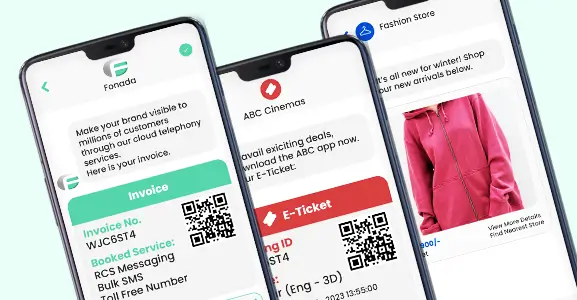ISDN stands for Integrated Services Digital Network. It is a telecommunications technology that was widely used in the past for transmitting voice, data, and video over digital telephone lines. ISDN was developed to provide improved quality and higher transmission speeds compared to traditional analog telephone networks.
These digital lines are made of copper lines and they are designed to replace outdated landline technology with a digital alternative. ISDN connections are well known for their ability to offer superior speeds and enhanced quality compared to traditional connections. By enabling faster speeds and more reliable connections, data transmission becomes easy and accessible.
Businesses often don’t prefer ISDN due to its high costs, limited scalability, and outdated technology. Additionally, ISDN requires dedicated lines, lacks integration with modern systems, and has limited feature sets compared to newer alternatives like VoIP.
In this blog post, we will be discussing the use cases of ISDN and how does it work. So, if you have any unresolved queries related to ISDN, go through the entire post to clear all your doubts
Lets get started…
The Evolutionary Journey Of ISDN
ISDN emerged as a solution to address the shortcomings of analog phone networks, which were plagued by frequent failures and unreliability when it came to long distance connections. In the 1960s, a shift towards a packet-based, digital switching system began to take place.
The International Telecommunications Union (ITU), a UN-affiliated organization, recognized the potential of ISDN and started endorsing it as a new data delivery system for operating companies in 1988. However, it took some time for communication providers to adopt ISDN due to the challenge posed by the different operating systems used by the major companies of that era. Eventually, the National ISDN 1 (N1-2 for short) was introduced in the 1990s.
Although this innovation promised improved communication quality, the establishment of a universally agreed-upon standard took time to materialize. Eventually, manufacturers like Motorola and USRobotics stepped in to facilitate a smoother transition for all stakeholders involved. Subsequently, ISDN was launched across the United States, offering consumers better pricing and higher-bandwidth internet access.
Today, ISDN has been supplanted by broadband internet access technologies such as DSL, WAN, and cable modems. Nevertheless, ISDN still serves as a backup option in cases of primary line failures.”
Essential Componenets Of ISDN And How Does It Work?
ISDN, or Integrated Services Digital Network, is an advanced digital communication technology that enables the transmission of voice, video, and data over conventional telephone lines. This technology utilizes dedicated channels to carry information efficiently.
To know the working functionality of ISDN, it’s essential to have understanding with the key components that contribute to its seamless operation.
There are two types of channels
- B (Bearer) channels
- D (Data) channels
Bearer Channels (B-Channels)
B-channels serve as storage for the primary user data, encompassing voice or video signals. Each individual B-channel possesses a bandwidth of 64 kilobits per second (Kbps) and can be merged to augment the overall bandwidth capacity.
Data Channels (D-Channels)
D-channels are used for signaling and control purposes. They carry control information, such as call setup, teardown, and signaling messages between devices.
Type of ISDN
ISDN supports two types of connections
- Basic Rate Interface (BRI)
- Primary Rate Interface (PRI)
Basic Rate Interface (BRI)
BRI provides two B-channels and one D-channel. It is commonly used for home and small enterprise connections for streamlined business communication.
Primary Rate Interface (PRI)
PRI provides multiple B-channels and one or more D-channels. The exact number of B-channels and D-channels depends on the specific PRI configuration. PRI is used in larger organizations with higher communication demands.
Signaling Protocol
ISDN uses signaling protocols to establish and control connections. The most common signaling protocol used in ISDN is called ISDN User Part (ISUP), which ensures proper communication between devices.
Call Setup
When making a call, ISDN establishes a connection by sending signaling messages over the D-channel. The calling device sends a call request, and the receiving device responds with an acknowledgment. Once the call is set up, data can be transmitted over the B-channels.
Call Teardown
When the call is complete, either party can initiate the call teardown process. This is done by sending signaling messages to release the resources allocated for the call.
Flexibility
ISDN offers flexibility in allocating channels based on communication needs. For example, a user can allocate more B-channels for higher-quality voice or video calls, or use fewer B-channels for lower-bandwidth data transfer.
Digital Quality
Since ISDN is a digital technology, it provides high-quality voice and data transmission without the noise or interference associated with analog systems.
Working of ISDN involve following steps
- Load the modem driver disk and program the modem.
- Point the modem towards the appropriate phone numbers.
- Configure the connection speeds for each line.
- Instruct your modem to dial your ISP (Internet Service Provider) using the provided phone number.
- If needed, enable BONDING on your modem to access higher speeds by allowing simultaneous dialing of both phone numbers.
Alternatives To ISDN
Some popular alternatives to ISDN (Integrated Services Digital Network) are listed below:
Voice Over IP (VoIP)
VoIP uses the Internet to transmit voice and multimedia communications. It provides similar functionality to ISDN for voice calls but offers more flexibility, scalability, and cost savings.
SIP Trunking
Session Initiation Protocol (SIP) trunking is a method of sending voice, video, and other unified communications over the Internet using SIP. It enables the connection of a private branch exchange (PBX) to the public switched telephone network (PSTN) without traditional phone lines.
Mobile Networks
With the widespread availability and improved quality of mobile networks, many businesses are opting for mobile phone services instead of fixed-line solutions like ISDN. Cellular networks provide voice and data services, making them suitable alternatives for voice communications.
Cloud-Based Telephony
Cloud based telephony solutions use cloud capabilities to deliver voice services over the Internet. These services are economical and they are designed to cater to all the communication worries within business environment
Digital Subscriber Line (DSL)
DSL is a technology that uses existing copper telephone lines to provide high-speed data transmission. While primarily used for internet access, DSL can also be used for voice calls by implementing Voice over DSL (VoDSL) solutions.
Fiber Optic Connections
Fiber optic networks offer high-speed data transmission over long distances. Businesses can use fiber optic connections to carry voice traffic using technologies like Voice over Fiber (VoF) or by integrating with VoIP systems.
What Are The Key Differences Between ISDN And DSL?
ISDN and DSL have following key differences:
Speed
DSL is faster than ISDN when it comes to transmitting data. ISDN baded on a dial-up service that uses a single line, while DSL connections are “always-on” and don’t need dialing. Due to such limitations, DSL can transmit data at speeds up to 100 Mbps, whereas ISDN’s maximum capacity is around 128 Kbps.
Connectivity
ISDN requires dialing to establish a connection, whereas DSL is always connected with the network.
Functionality
ISDN and DSL both provide comparable functionality, although they employ distinct approaches to accomplish this. Each technology utilizes different underlying methods and techniques to deliver their respective services.
Benefits Of ISDN
ISDN, or Integrated Services Digital Network, is a telecommunications technology that was developed to provide faster and more reliable digital communication over traditional analog phone lines. Although ISDN has been largely replaced by newer technologies like broadband and fiber optic connections, it still has some benefits in certain scenarios.
Here are some of the advantages of ISDN:
Digital Connectivity
ISDN architecture is designed to offers a fully digital connection, allowing for the transmission of voice, data, and video signals over the same network. This digital nature ensures high-quality communication with minimal signal degradation or noise interference.
Faster Data Transfer
ISDN offers swifter data transfer speeds in contrast to conventional analog phone lines. It is capable of accommodating data rates reaching 128 Kbps (kilobits per second) through the Basic Rate Interface (BRI), and achieves even higher speeds via the Primary Rate Interface (PRI).
Multiple Channels
It allows for the simultaneous use of multiple channels or lines on a single connection. With BRI, you can have two bearer (B) channels for voice or data and one delta (D) channel for signaling. PRI can provide even more channels, depending on the configuration, allowing for higher capacity and better handling of multiple simultaneous connections.
Reliability
It offers a reliable connection with low latency and minimal packet loss. It is less susceptible to noise and interference compared to analog lines, resulting in clearer voice calls and more stable data transmission.
Integrated Services
ISDN architecture provides support for a range of services and protocols, including voice, data, video conferencing, fax, and even internet access. By enabling the integration of diverse communication services within a unified network, it streamlines infrastructure and diminishes expenses.
Wide Coverage
ISDN infrastructure has been established in many areas, making it accessible in both urban and rural locations. In areas where high-speed internet options like broadband or fiber are limited, ISDN can provide a viable alternative.
Conclusion
ISDN has been instrumental in telecom’s evolution, serving as a vital voice and data communication technology. It was designed to offer superior speed and reliability, it enabled voice, video, and data transmission through a single digital network. However, with advancements like broadband and Ip technology, ISDN’s significance has diminished. Many countries and telecom providers are phasing out ISDN services, replacing them with advanced alternatives such as fiber optics, DSL, and VoIP, which deliver enhanced capabilities and performance in today’s digital landscape.
FAQs
The isdn full form of ISDN is Integrated Services Digital Network. It is a telecommunication technology that transmits voice, data, and video over digital telephone lines. It enables faster and more efficient communication compared to traditional analog systems.
Examples of ISDN implementations include:
PRI (Primary Rate Interface): A type of ISDN service that provides multiple channels for voice and data transmission.
BRI (Basic Rate Interface): A basic ISDN service that offers two B-channels for data and one D-channel for signaling and control.
ISDN modems: Modems that use ISDN technology for high-speed internet access.
Videoconferencing systems: ISDN is often used to transmit audio and video signals for real-time remote meetings.
Advantages of ISDN include faster data transfer rates, integrated voice and data communication, better call quality, multiple services on a single line, and reliable connectivity.
ISDN consists of two lines: one for data (B channel) and one for signaling and control information (D channel). However, ISDN can also support multiple B channels for increased data capacity.
The invention of ISDN is credited to Bell Labs.

Dec 11, 2024
Top Contact Center Optimization Tools For 2024
“A thriving business knows how to fetch maximum output from limited resources by optimizing ca... Read More
Nov 13, 2024
What Is Brand Communication? CPaaS Role Explained
Did you ever wonder why some advertisements grab your attention instantly, while others do not? The... Read More
Nov 01, 2024
What Is Automated Messaging And How Does It Work?
Automated messaging or text automation empowers businesses and marketing professionals to connect wi... Read MoreLatest Updates
From Fonada
Industry Insights, Trends, Innovations, Updates, and Case Studies from Industry Experts
View
Customer
Reviews
Discover why our customers love us - read their authentic and heartfelt reviews!
View
Case
Studies
Explore real-life scenarios, offering analysis, and solutions to practical challenges
View
Convert Leads Into Sales With Fonada
Trusted CPaaS Solution Provider








